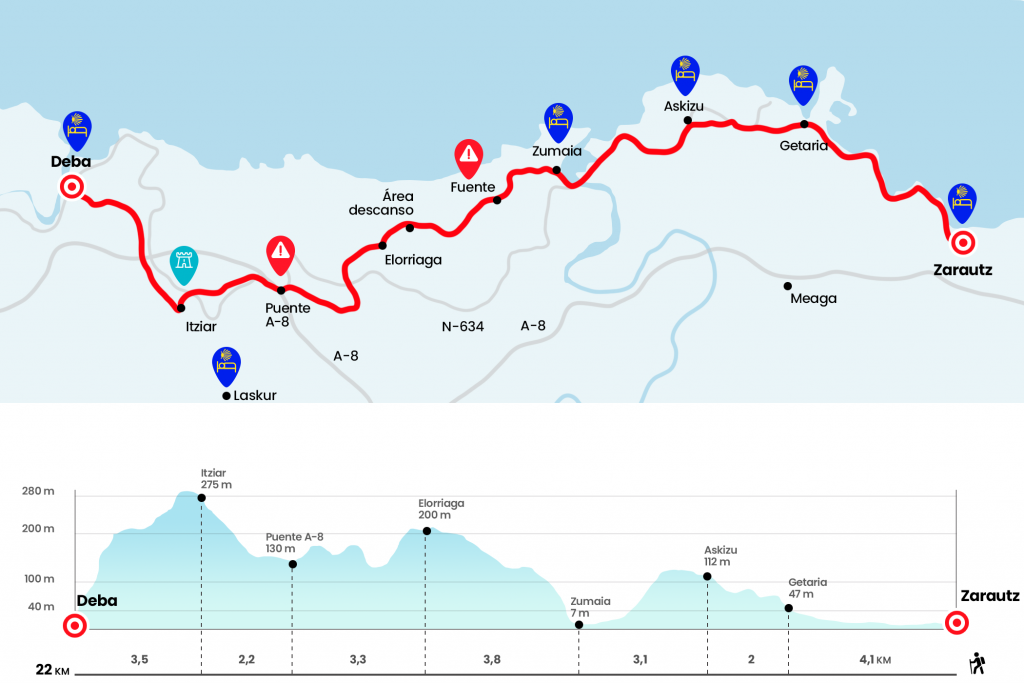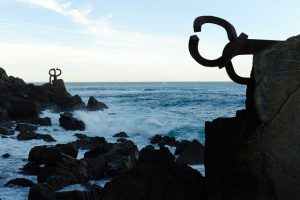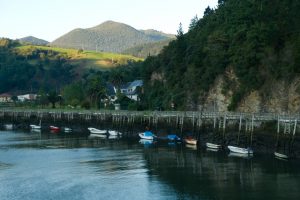Article translated by an automatic translation system. Press here for further information.
Zarautz to Deba stage
Important breakdowns between Guetaria, Zumaia and Deba. Cheer!
Information about the stage 3: Zarautz to Deba stage

Enlarge map
The route
- Km 0. Zarautz (All services)
To reach Getaria there are a couple of possibilities:
1. We can take along the Church of Santa Maria the road to Meagas and take a few hundred meters later the road to the hermitage of Santa Barbara. It is an old road that climbs in a strong echo between vineyards of txakolí to the vicinity of the temple, consecrated in 1709 thanks to the contributions of the locals. From the hermitage you get a privileged panorama of Zarautz and its extensive beach. Then the Official Road continues on a stretch until the road GI-3391 that we take down for a few hundred meters after turn left, eye, if you want to visit Getaria at this point continue straight on the road 400 meters to the village. The official road continues on the aforementioned crossing to the left to Askizu.
2nd. The second option runs through the pedestrian walkway that runs parallel to the N-634, a journey that took 8 years to be built. The walk is flat and very frequented by sports and Zarautztarras fishermen. We are seeing Mount San Antón, popularly known as the ‘mouse’, and at the entrance of Getaria, the cradle of Juan Sebastián Elcano, we can leave the Camino a few moments and visit the magnificent port of this marine village, which is accessed under the passage of the church of San Salvador.
- Km 4.1. Getaria (All Services)
We leave Getaria on a road that departs from Herrerieta Street. The road progresses to the San Prudencio district, where the Kanpaia hostel is located, and then leads to the road GI-3392. About 550 meters later we left the asphalt towards the Aziategi farmhouse, between vineyards and maizales. A final echo puts us next to the church of San Martin de Tours, in the Guetarense district of Askizu. Next to the parish there is a fountain where we can take a break. Also, a few meters away is the hostel Agote Aundi.
- Km 6.1. Askizu (Lodge-Bar)
The itinerary leaves Askizu and advances with unbeatable views of the Cantabrian and Zumaia. We descend to the Guipuzkoan villa along the hillside of the mountain to the N-634. Next to the road, on the right hand, is the Museum House of the painter Ignacio Zuloaga and, attached to it, the chapel of Santiago, of the 15th century. We finally reach Zumaia by crossing the Urola River and down the stairs to cross the Los Angeles Sorazu promenade.
- Km 9.1. Zumaia (All services)
We dismissed the villa ascending to the convent of San José de las Carmelitas Descalzas, which functions as a municipal hostel in July and August, and by the chapel of Arritokieta. Returning to the view you get a good final overview of Zumaia and the mouth of the Urola. The rural road leads to a road that leads to the rest area of Elorriaga (Km 12,4), with a fountain and several tables. The Debarés district of Elorriaga can be reached both on the left, by track, and on the right, by road. At the entrance of this mountain core is a tavern.
- Km 13. Elorriaga (Bar)
In Elorriaga we follow the itinerary of the Camino de Santiago because there is also the one of the GR-121, which moves closer to the coast. The Camino goes down to the National and crosses it to climb through a brutal ramp that inhabits us on a wooded road. This 'broken legs' section draws several portilles and goes back to the N-634, at the height of the Mardari neighborhood with bar-restaurant at the foot of the road. We passed over the A-8 (Km 16,3) and followed with caution by the National. We leave it shortly on the right and we move along a path that snaps a large section of road, and it ascends back to the N-634 with a last very long echo. We finally reach Itziar, where we deserve another rest. The shrine of Santa Maria de Itziar has been an obligatory high on the Camino del Norte. The building is from the 16th century and is built on a Romanesque temple. Inside, presiding over the altar is the height of the Virgin of Itziar, a venerable image of the 13th century. The hymn to the virgin says: "Ave, de Itziar la Virgen Bella - Ave, Dear Mother of the Star Sea".
- Km 18.5. Itziar (Bars. Store)
A runway, which unfortunately hides the old road, climbs the final meters to the graveyard and goes down to Deba, which shows a strong imbalance in the last section. Next to the trail is the hermitage of San Roque, which we can see in a colorful hornacine adorned with flowers and a pair of vieiras (Km 21). As soon as we enter the population, we pass by IES Mendata and continue along Mogel Street to take the elevator. The new hostel opened in June 2014 is located in the railway station building, at the foot of the river. Before going there you have to go through the Tourist Office to seal and register (Phone 943 19 24 52). If it is closed it can be done in the premises of the Municipal Police, which are under the supports of the plaza.
- Km 22. (All services)
The difficulties
Remarks
In images
What to see, what to do
The hostels

¿Do you want to send any photo of "The Camino de Santiago"?
If you have any photos of "El Camino de Santiago" that you want to share with us, you can send them to us and enlarge the photo gallery


Forum: What pilgrims think about the Camino de Santiago
See all